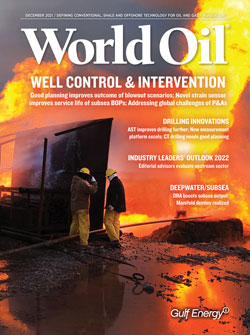Issue: December 2021
Features
Despite exacting a heavy environmental and financial toll, routine flaring remains a persistent practice in the oil and gas sector. The technical solutions for ending flaring are both practical and financial in nature. Three hurdles are commonly faced when implementing flare gas to power projects.
Comprehensive new logging services focus on enhancing subsurface insight, optimizing drilling performance and ensuring consistent well delivery, to help operators minimize cost and risk while maximizing asset value.
The search for new energy sources has focused renewed attention on reducing costs and improving drilling efficiency. One company is conducting scientific research to launch innovative technologies to address the challenge.
Mitigating or controlling the outcome of significant unknowns is most effective when done from the very beginning to ensure that coiled tubing is the right technology for the application. The feasibility study is, therefore, arguably the most important stage in project planning.
After the debacle that 2020 was for so many companies and professionals in the global E&P industry, there was great hope that there would be recovery this year that would gain in momentum, as the months went by. Instead, what everyone got was a muted recovery, as U.S. operators and OPEC+ members exerted uncharacteristic restraint with regard to drilling and production, respectively.
Subsea injection of drag reducing agents (DRA) into flowlines reduces friction and substantially increases production. For years, DRA has been widely used onshore, and in upstream transfer and export systems. Today, breakthrough advancements allow DRA to be injected into subsea production systems.
There has never been a more challenging time for the energy industry. In the subsea sector, the search for optimised costs, minimised carbon emissions, and maximised performance is set to intensify, as oil prices continue their unpredictable trajectory.
Gas bulls feasting, as production nears all-time high
Researchers at NETL and its partners are advancing technologies capable of improving the performance, reliability and flexibility of methods to produce, transport, store and use hydrogen
Special Focus
Wild Well Control says operators should consider environmental concerns during well planning, including location, access points, proximity to water, and other issues that can make a difference between an expedited, efficient and safe blowout scenario and one that is complicated, costly and dangerous.
A company has developed a novel sensor technology to overcome direct measurement of load using strain gauges that allows for accurate measurement of strains in a wide measuring range, as part of a subsea wellhead integrity monitoring system.
The dramatic rise in orphaned oil and gas wells, combined with multi-well pads and their own set of P&A issues, poses unprecedented challenges to oil and gas companies. Mitigating these challenges and potential risks will require well control experts, who take a new approach and leverage advanced technology and expertise.
Columns
ESG and the New Vocabulary
Looking for better thinking in the year ahead
Heat exchangers
Latin America’s oil industry needs greater political stability to keep growing
Emerging into the New Normal with a New Approach
U.S. operators rein in spending
Resources



